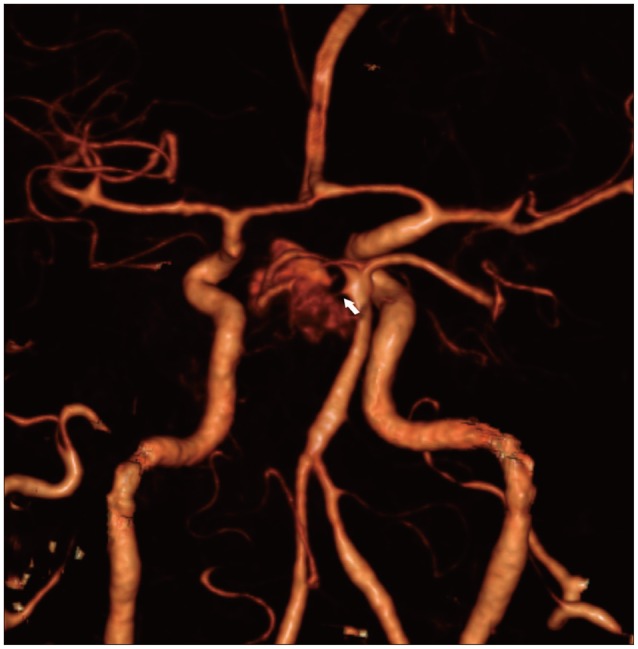J Korean Neurosurg Soc.
2014 Nov;56(5):428-430. 10.3340/jkns.2014.56.5.428.
Fatal Traumatic Subarachnoid Hemorrhage due to Acute Rebleeding of a Pseudoaneurysm Arising from the Distal Basilar Artery
- Affiliations
-
- 1Department of Neurosurgery, Medical Research Institute, Pusan National University Hospital, Pusan National University School of Medicine, Busan, Korea. namdark@daum.net
- KMID: 2018103
- DOI: http://doi.org/10.3340/jkns.2014.56.5.428
Abstract
- Isolated traumatic pseudoaneurysms of the basilar artery are extremely rare but often fatal resulting in a mortality rate as high as 50%. A 51-year-old man presented with craniofacial injury after blunt trauma. A brain computed tomography (CT) scan showed thick basal subarachnoid hemorrhage associated with multiple craniofacial fractures, while CT angiography revealed contrast extravasation at the distal basilar artery with pseudoaneurysm formation. After this primary survey, the condition of the patient suddenly deteriorated. Conventional angiography confirmed the contrast extravasation resulted from pseudoaneurysm formation, which was successfully treated with endovascular coil embolization. Decompressive craniectomy and coma therapy with propofol were also performed. However, the patient died on the 7th hospital day because of the poor initial clinical condition. The current case is the first report of acute pseudoaneurysm rupture arising from the basilar artery within the first day after trauma. Our findings suggest the possibility that pseudoaneurysm rupture should be considered if brain CT shows thick traumatic subarachnoid hemorrhage on the basal cistern with a basal skull fracture.
MeSH Terms
Figure
Reference
-
1. Bank WO, Nelson PB, Drayer BP, Wilkins RH, Rosenbaum AE. Traumatic aneurysm of the basilar artery. AJR Am J Roentgenol. 1978; 130:975–977. PMID: 417604.
Article2. Connor SE, Martin AJ, Deasy NP, Jeffree MA, Strong AJ. Traumatic basilar pseudoaneurysm with a basilar-cavernous arteriovenous fistula. Neuroradiology. 2001; 43:249–253. PMID: 11305761.
Article3. Feldges A, Nau HE, Reinhardt V. Two cases of sudden death by rupture of traumatic and bacterial aneurysms. Intensive Care Med. 1989; 15:400–402. PMID: 2808899.
Article4. Ko JK, Lee TH, Lee JI, Choi CH. Endovascular treatment using graft-stent for pseudoaneurysm of the cavernous internal carotid artery. J Korean Neurosurg Soc. 2011; 50:48–50. PMID: 21892405.
Article5. Loevner LA, Ting TY, Hurst RW, Goldberg HI, Schut L. Spontaneous thrombosis of a basilar artery traumatic aneurysm in a child. AJNR Am J Neuroradiol. 1998; 19:386–388. PMID: 9504500.6. McElroy KM, Malone RJ, Freitag WB, Keller I, Shepard S, Roychowdhury S. Traumatic pseudoaneurysm of the basilar artery. Am J Phys Med Rehabil. 2008; 87:690–691. PMID: 18645327.
Article7. Ong CK, Ong MT, Lam DV, Wenderoth JD. Catastrophic delayed rupture of a traumatic aneurysm of the distal superior cerebellar artery in a child. J Clin Neurosci. 2010; 17:515–517. PMID: 20122833.
Article8. Quintana F, Diez C, Gutierrez A, Diez ML, Austin O, Vazquez A. Traumatic aneurysm of the basilar artery. AJNR Am J Neuroradiol. 1996; 17:283–285. PMID: 8938300.
- Full Text Links
- Actions
-
Cited
- CITED
-
- Close
- Share
- Similar articles
-
- A Pseudoaneurysm Appeared after Rebleeding
- Ruptured Pseudoaneurysm after Minor Head Injury, is it Traumatic?
- Post Traumatic Pseudoaneurysm Arising from V4 Segment of Vertebral Artery: A Case Report
- Angiographically Progressive Change of Traumatic Pseudoaneurysm Arising from the Middle Meningeal Artery
- Traumatic Intracerebral and Subarachnoid Hemorrhage Due to a Ruptured Pseudoaneurysm of Middle Meningeal Artery Accompanied by a Medial Sphenoid Wing Dural Arteriovenous Fistula





